Transport in Bhutan uses about 8,000 kilometres (5,000 mi) of roads and four airports, three of which are operational and interconnected. Paro Airport is the only airport which accommodates international flights. As part of Bhutan's infrastructure modernization programs, its road system has been under development since the 1960s. There are no railways, and as Bhutan is a landlocked country with no major waterways, there are no ports.

Bhutan has diplomatic relations with 54 of 193 member states of the United Nations and the European Union. Bhutan's limited number of such relations, including the absence of formal relations with any of the permanent members of the United Nations Security Council, is part of a deliberate isolationist policy of limiting foreign influence in the state. This stance has been safeguarded by close relations with India, of which Bhutan has previously been considered a protected state.

The Royal Bhutan Army is a branch of the armed forces of the Kingdom of Bhutan responsible for maintaining the country's territorial integrity and sovereignty against security threats. The King of Bhutan is the Supreme Commander in Chief of the RBA. The Chief Operations Officer is Goonglon Gongma Batoo Tshering.
Kuensel is the national newspaper of the Kingdom of Bhutan. It was the only local newspaper available in Bhutan until 2006 when two more newspapers were launched. The government of Bhutan owns 51% of Kuensel while 49% is held by the public.

Bhutan, officially the Kingdom of Bhutan, is a landlocked South Asian country situated in the Eastern Himalayas, between China in the north and India in the south. A mountainous country, Bhutan is known locally as "Druk Yul" or "Land of the Thunder Dragon", a name reflecting the cultural heritage of the country. The exonym Bhutan likely derives from the Prakrit hybrid word Bhŏṭṭaṃta, a name referring to its geographical proximity to Tibet (Bhŏṭṭa). Nepal and Bangladesh are located near Bhutan but do not share a border with it. The country has a population of over 727,145 and territory of 38,394 square kilometres (14,824 sq mi) and ranks 133rd in land area and 160th in population. Bhutan is a constitutional monarchy with a king as the head of state and a prime minister as the head of government. Vajrayana Buddhism is the state religion and the Je Khenpo is the head of the state religion.
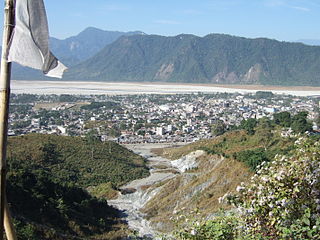
Phuntsholing, also spelled as Phuentsholing, is a border town in southern Bhutan and is the administrative seat of Chukha District. The town occupies parts of both Phuentsholing Gewog and Sampheling Gewog.
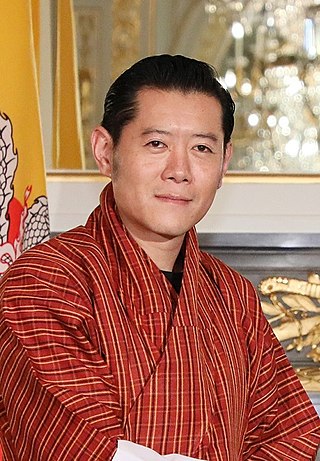
Jigme Khesar Namgyel Wangchuck is the Druk Gyalpo, the monarch of the Kingdom of Bhutan. After his father Jigme Singye Wangchuck abdicated the throne, he became the monarch on 9 December 2006. A public coronation ceremony was held on 6 November 2008, a year that marked 100 years of monarchy in Bhutan.
The various mass media in Bhutan have historically been government-controlled, although this has changed in recent years. The country has its own newspapers, television and radio broadcasters and Internet Service Providers.
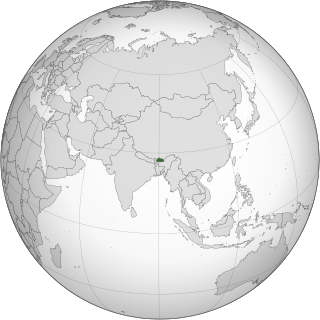
Lesbian, gay, bisexual and transgender (LGBT) people in Bhutan face legal challenges that are not faced by non-LGBT people. Same-sex sexual activity was decriminalised in Bhutan on 17 February 2021.

The Kingdom of Bhutan and the People's Republic of China do not maintain official diplomatic relations, and relations are historically tense. The PRC shares a contiguous border of 470 kilometers with Bhutan, and its territorial disputes with Bhutan have been a source of potential conflict. Since 1984, the two governments have conducted regular talks on border and security issues to reduce tensions.
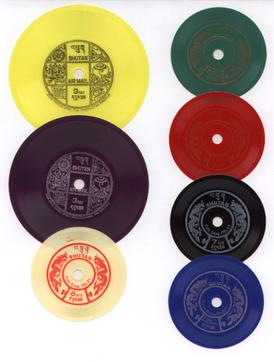
The first postage stamps of Bhutan were issued in 1962, the same year that the first motorable road was opened. Before that there was a mail delivery system in place for official mail using mail runners, and between 1955 and 1962 revenue stamps were accepted as payment for internal mail. With the opening up of Bhutan in the early 1960s, a formal postal system was introduced.
Gelephu Airport is located in Samtenling Gewog, about three kilometres (1.9 mi) from Gelephu in Sarpang District, Bhutan. The airport has been constructed on an area spanning over 500 acres (200 ha) and came into regular use in late 2017. It is one of only four airports in Bhutan.
AumDorji Choden is a Bhutanese politician. She was appointed minister of Bhutan's Works and Human Settlement Ministry in 2013, making her the first woman to serve as a minister in Bhutanese cabinet.

The Bangladesh, Bhutan, India, Nepal (BBIN) Initiative is a subregional architecture of countries in Eastern South Asia, a subregion of South Asia. It meets through official representation of member states to formulate, implement and review quadrilateral agreements across areas such as water resources management, connectivity of power, transport, and infrastructure.
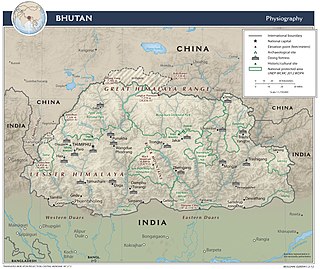
The Bhutan–China border is the international boundary between Bhutan and Tibet, China, running for 477 km (296 mi) through the Himalayas between the two tripoints with India.

Doklam, called Donglang by China, is an area in Bhutan with a high plateau and a valley, lying between China's Chumbi Valley to the north, Bhutan's Ha District to the east and India's Sikkim state to the west. It has been depicted as part of Bhutan in the Bhutanese maps since 1961, but it is also claimed by China. The dispute has not been resolved despite several rounds of border negotiations between Bhutan and China. The area is of strategic importance to all three countries.
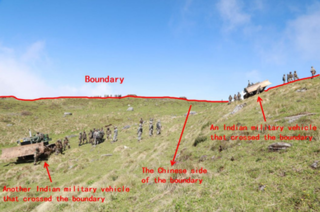
The 2017 China–India border standoff or Doklam standoff was a military border standoff between the Indian Armed Forces and the People's Liberation Army of China over Chinese construction of a road in Doklam, near a trijunction border area known as Donglang, or Donglang Caochang, meaning Donglang pasture or grazing field, in Chinese. On 16 June 2017 Chinese troops with construction vehicles and road-building equipment began extending an existing road southward in Doklam, a territory that is claimed by both China and India's ally Bhutan.

The COVID-19 pandemic in Bhutan was a part of the worldwide pandemic of coronavirus disease 2019 caused by severe acute respiratory syndrome coronavirus 2.
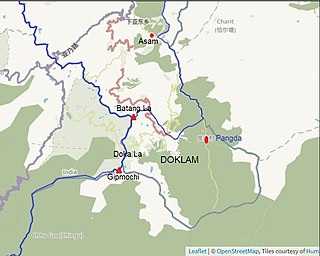
Pangda (庞达村) is a village just east of the Doklam plateau and approximately 10 km east of the India-Bhutan-China trijunction. The village was constructed by China in 2020 along the Torsa River.















